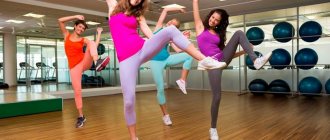Jumping is great cardio and also burns fat.
The jump rope is an indispensable element in the training of athletes, boxers, figure skaters, football players, and tennis players. And in general, jumping is one of the best ways to burn fat and keep your body toned.
The dynamic load when jumping is minimal - due to the high pace, the muscles do not fully contract or stretch. But this does not mean that the jump rope does not pump them up: jumping involves the calf muscles, quadriceps and hamstrings. Indirectly, the load also extends to the buttocks and abdominal muscles.
With the correct technique, the torso muscles are practically not loaded, but due to the static nature, posture and the vestibular apparatus improve.
The greatest burden falls on the cardiovascular system - this normalizes blood pressure and improves breathing. Studies have shown that after 6 weeks of 10-minute workouts with a jump rope, athletes had the same cardiovascular improvement as those who jogged for half an hour.
Everyone knows that jumping is an excellent tool against excess weight. Theoretically, about 1000 kcal are burned per hour - more than walking (300), swimming (550) and cycling (700). It is clear that jumping without stopping for an hour is difficult, but combined training with a jump rope is much more effective than without it.
Another advantage of jumping is the development of coordination, dexterity and attention. Scientists have proven that jumping rope develops both hemispheres of the brain: spatial orientation and memory improve. In addition, exercises require constant concentration.
And of course, a jump rope is the most accessible for exercise: cheap, convenient and unpretentious.
Jumping rope for weight loss: benefits and harms
The benefits of a jump rope would seem obvious. Jumping strengthens the muscle corset, helps you lose weight, is an excellent prevention of vascular diseases and brings many other benefits to the body. But you still need to know some subtleties so that such an effective and simple cardio workout does not lead to injury.
- It is important to choose the correct length of rope. If your height is less than one and a half meters, then the length of the “unit” should be a little more than 2 meters. Then for every 20 centimeters of growth you need to add 30 cm to the rope. This is an extremely important aspect, otherwise injuries and discomfort during jumping cannot be avoided. There is an easier way to select the ideal dyna. Take the rope by the handles and stand in the middle with your feet. Now raise your arms up. They should be on par with the armpits.
- For training, you should choose a tight set of clothes. A T-shirt and pants that are too wide will get in the way and cling.
- Girls without a bra should not do even a couple of jumps. Even small breasts should be securely pressed.
- Don't ignore the issue of shoes. The shock-absorbing sole will allow you to make jumps softer. Never jump barefoot!
- First you need a good warm-up. Give it at least 10 minutes. After all, jumping uses not only the muscles of the legs, but also the whole body.
- To perform the jumps correctly, it is important to place your feet together and press your elbows to your hips. The arms do not strain, only the hands work.
- When performing a jump, you do not need to stand on your full foot, only on your toes.
- Beginners should not jump too high, 3-4 cm from the floor is enough.
- How long to practice? As soon as you find it difficult to speak or feel short of breath, take a break for 2 minutes. Stabilize your breathing and start over.
- Each time increase your training time and approach time. And soon you will notice that the exercises come to you without much difficulty and noticeably transform your figure.
- Exercise before eating or two hours after eating.
To say that the benefits of such activities for the body are great is to say nothing. All professional athletes (including brutal football players and boxers) must include a jump rope in their training program. It is an effective, convenient and versatile tool that provides great benefits to your cardiovascular system and fitness. But first things first.
- Jumping can replace running, but at the same time saves a lot of time. After just a week of regular and short-term exercise, you can notice that more muscles have appeared in your body. Especially in the shoulder girdle, lower back and abdominal area.
- There is a noticeable increase in endurance, because while jumping you have to maintain a special rhythm, which is not so easy. This is what will allow you to forget about fatigue throughout the day over time. In addition, this will have a positive effect on the ability to breathe properly and maintain balance.
Try to learn how to breathe correctly as soon as possible, this will help you avoid pain and burning in your lungs after a long workout.
- If your back often hurts due to a sedentary lifestyle or, conversely, constant carrying of heavy objects, then jumping rope will help here too.
This is a good exercise machine for the back, because the spine is stretched in the process, which will allow you to forget about the problem of scoliosis.
- Jumping rope for weight loss is incredibly effective. You can burn more than 900 kcal by exercising just 10 minutes a day. Humanity has not yet come up with a more effective calorie burner. Needless to say, this will help you avoid cellulite and have a magical aesthetic effect on your legs.
- Jumping rope is good for the heart. Blood circulates faster, which has a positive effect on blood pressure. Regular exercise will help you avoid a heart attack in old age. This is very important, because heart disease kills the largest number of people in the world.
- Such exercises are the prevention of skeletal diseases. Over time, problems with microarchitecture and bone fragility may arise; a jump rope will protect you from this.
- Few people know, but jumping rope is an excellent anti-stress. Frequent rhythmic exercise has a positive effect on the nervous system.
Jumping rope is very effective in losing weight, but it also has pitfalls. It is important to follow the execution technique described above and carefully read the contraindications. For example, if you have more than 10 kg of excess weight, then you should wait a while with the jump rope. Who else can't do it?
- People with diseases of the spine, cardiovascular system, varicose veins. Jumping rope is a prevention of these diseases, but not a cure. If you already have problems, you should not choose this exercise for yourself.
- Hypertensive patients. If you have problems with blood pressure or frequent headaches, then jumping can aggravate the situation.
- Pregnant and breastfeeding women also do not need to use a jump rope.
- People with high levels of obesity. In this case, the rolling pin can greatly harm the joints. Moreover, such people are not even recommended to run. It's better to start with cycling or an elliptical trainer.
- Women with large breasts. Jumping rope can lead to sagging mammary glands.
Consult your doctor, and if you do not have such contraindications, then do not forget about the enormous benefits of jumping rope not only for weight loss, but for the entire body as a whole. Just be careful during your first jumps, don’t forget about safety precautions, and very soon you will notice how this simple home exercise machine will make your body slimmer and your body more resilient. The main thing is regularity!
There are risks - the exercise is for healthy people, there are many contraindications
A jump rope is a tool with a convenient safety feature: incorrect technique prevents overtraining. Errors and fatigue cause work stoppage but do not pose a risk of serious injury.
However, there are contraindications:
• heart problems and unstable blood pressure – the heart bears the main load. Varicose veins also interfere.
• injuries to the joints, ligaments of the knees or ankles due to the high likelihood of relapse.
• excess weight – if it is 15% higher than normal, then it is better to choose another exercise.
• old age – here it is better to use gentle activities like Nordic walking.
Contraindications for jumping rope
For those who cannot visit fitness clubs and gyms, jumping rope can be a beneficial alternative. But do not forget that such loads have contraindications. They can be temporary or absolute. Temporary ones include pregnancy, overweight or a full stomach. But you should take a more serious approach to the absolute contraindications of jumping rope:
- cardiovascular diseases;
- hypertension;
- diseases of the spine and osteoarthritis;
- varicose veins;
- eye pathologies.
It is important to know which muscles work when jumping rope, so as not to overload the body with unnecessary stress. When practicing jumping rope, almost all muscles are involved. But the most active loads are subject to:
- calf;
- femoral;
- gluteal;
- bark.
Up to 70 percent of the load goes to the calf muscles. This is important to know for girls who are interested in whether jumping rope is good for beautiful legs.
Such exercises help to give a beautiful shape to the quadriceps, but this requires special technique. The arm muscles are subject to minimal stress. Therefore, for this part of the body it is necessary to include other loads in the complex.
How to jump correctly
Jump ropes have thousands of options - standard, high-speed (with bearings in the handles), weighted, with counters. Beginners start with simple ones, but professionals (there are tournaments and even a federation in jumping rope) recommend more difficult options.
A rope that is too light interferes with perception: the athlete does not feel the speed and does not always choose the right time to jump. A weighted rope eliminates this problem and is easier to control and pace.
In addition to weight, length plays an important role. If you stand in the middle of the rope, the handles should reach your armpits or be slightly higher.
The number of jumps depends on physical fitness, but the technique is unchanged:
• warm-up before jumping: stretching, squats;
• you need to land on your toes, in no case on your heels - this is fraught with injuries;
• the back is straight, the elbows are pressed to the body, the shoulders and forearms are almost static, the hands are responsible for rotation;
• legs are always slightly bent at the knees;
• it is better not to choose a surface that is too hard or too soft - asphalt and mats are excluded;
• feet must be wearing shoes; bare feet can injure your feet;
What equipment should you wear when jumping rope?
Don't assume that clothing is not important during class. The equipment should be comfortable and not restrict movement.
It can be:
- shorts;
- leggings;
- bicycle shorts;
- sports trousers;
- T-shirts;
- T-shirts.
All clothing should fit the body. Sneakers are ideal as footwear. They are capable of cushioning in case of an unsuccessful landing. For beginners, choose ordinary models of jump ropes. For the more active and serious, they are already at the appropriate level:
- jump ropes that can be adjusted in length;
- with counters;
- with weights;
- beaded;
- leather;
- with internal steel cable.
Most of these models are suitable for professionals. If you want to purchase a modern analogue, then it is better to make a choice in favor of models with meters. They show the number of jumps and calories burned.











